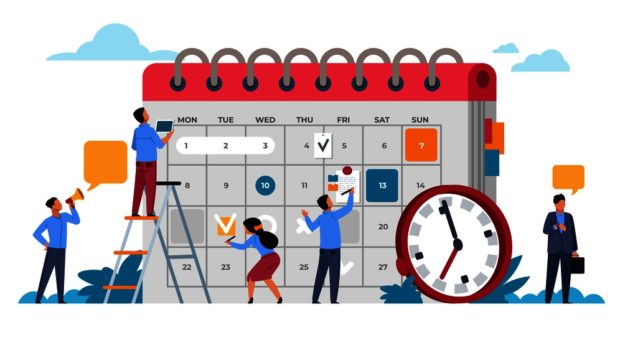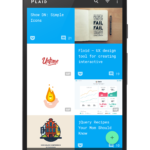How to Create A Social Media Content Calendar
This blog post will tell you how to create a social media content calendar to streamline all your accounts’ activity.
Marketers here would agree with me when I say that maintaining consistency and uniformity in the content posted on social media is a struggle. There are multiple accounts to handle, each with varying policies that often create frustration and confusion.
As a result, you fail to provide the audience with timely updates or relevant content – leading to an unsuccessful social media marketing strategy.
And this is where a content calendar steps in to save the day.

What is a Content Calendar for Social Media?
A social media content calendar is just what the name implies: A document that keeps track of all your posts in advance. With this document in place, you can save yourself from the terror of a looming deadline and keep your social media strategy organized.
Some benefits of building and maintaining a social media content calendar include:
Saves Time & Stress
Social media requires effort and attention every single day. With the help of a calendar, you can plan ahead, delegate your work, avoid multitasking, and note down all brainstormed ideas for later.
Basically, it’s a way to keep you organized and spare you from desperately looking for content ideas at the last minute.
Post Consistently
When it comes to social media networks, posting consistently is the key to audience engagement. At the same time, irregular posting can lead to an out-of-sight, out-of-mind scenario, regardless of how well you write.
Populating the calendar with a posting schedule ensures that you are consistently showing up on the visitor’s newsfeed. It will also keep you prepared for special occasions and product launches.
Remain Relevant
Sometimes you can indeed ‘wing it,’ but that’s not a method that will give you profitable results in the long-term. When you are in a hurry to meet the deadline, there is a good chance that you may overlook a topic that was already discussed before. Or perhaps typos and grammar mistakes that you didn’t have time to check before publishing.
However, the audience spots these blunders quickly!
A content calendar will help you prevent such mistakes and ensure that you provide the audience with fresh and relevant content.
Encourages Team Collaboration
Given the competition, it’s not unusual to have multiple personnel working on a single social media post such as designers and content creators. Due to the recent pandemic, the remote work culture has increased significantly, and you may also have team members working from home, alongside their in-house counterparts. In this case, communication can be a challenge if you don’t have a suitable channel in place.
A social media calendar helps you gather your assets – both human and digital effectively. It will also enhance collaboration between the team members, giving you a space to brainstorm ideas, make edits, and plan out future strategies on a single dashboard.
Analyze Performance
Measuring the effectiveness and success of your social media marketing efforts is only possible if you keep track of the metrics.
With a centralized hub for all your social media activities, you can easily analyze the performance of specific platforms, campaigns, and post types.
Also, establishing specific goals is necessary. By keeping an eye on the benchmarks, you can modify the strategy and give your audience the content they need.
How to Create a Productive Social Media Content Calendar?
Now that you know the benefits of having a social media content calendar, it’s time to talk about how to actually create one.
Evaluate your Marketing Goals
Whether you want to modify your entire social media presence or build one from scratch for a new business, it’s essential to identify your specific goals. You must check if your goals align with your long-term business goals.
Here you should also define who your target audience is and what type of content appeals to them.
Audit Existing Profiles and Content
Analyzing your current accounts will help you identify areas of improvement and platforms to rework completely.
Take a comprehensive look at each social media profile. Note down the number of followers/subscribers they have. Check your most successful posts, campaigns, and tactics. Track the engagement (shares, likes, comments, clicks) each of them received.
And most importantly, identify the gaps present in your existing social media accounts. This should include the days you (or your team member) missed to post and the type of posts that failed to create a buzz with the audience as well.
Identify the Channels
While it may seem necessary to remain active on every social media network – there is no such need for a successful marketing strategy. You see, each social media network has its own unique user demographics. There is also a particular type of content that pertains to each audience and the profile.
For example, Facebook is a leading social media network in the world. However, it is most popular with adults aged above 25. At the same time, younger audiences (above 13) prefer to use Instagram and Snapchat for its energetic content, while women are commonly found on Pinterest.
You should also step back to your goals. Decide which channels resonate with your business goals. Some social media platforms are great when it comes to building engagement but may not do well to increase your sales. Others might give you a lot of traffic but will not create a warm community.
Analyzing each platform will give you an idea of the areas to focus on and the networks you can neglect.
Decide Post Frequency
There is no clear solution for determining the post frequency and the best time to post. This is because each social media account has its own period of engagement.
For example, Facebook users are more active during the work hours while engagement drops after their 9 – 5 shift is over. On the other hand, 4:00 pm and 10:00 pm are the ideal time to post on Instagram.
In addition, take a look at the content you already have and the amount of content you can handle creating. Be honest about your limitations and focus on maintaining quality – rather than quantity.
Create a Repository of Assets
Visuals are an essential element in a social media marketing strategy. Having a digital library full of all branding materials such as logos, images, and other visuals will make it easy to store the material and share anything that is required with a single click.
You can also use this time to add more content to your library that can be used in the future. For example, infographics are a great way to convey information without the need for lengthy texts.
With online videos predicted to account for more than 82% of the internet traffic by 2022, you need to consider the option going forward too.
Establish Responsibilities
If you are working in a team, assign tasks according to their specialties.
For example, who will be in charge of editing and proofreading the content? What will be the process of brainstorming content ideas, approving new posts, and of course, creating the content? Do you need a graphic designer, or will you play around with readily-available stock photos?
You can also select tools that will help you automate tasks and publish them according to a predefined timeline. This will save you from the manual work and make the process more seamless.
Start Scheduling
Once you have figured out the workflow, it’s time to load everything on the content calendar and enjoy the peace of mind and sanity that it offers. Keep in mind that you should regularly check your calendar, measure the efforts, and tweak posts accordingly.
Final Thoughts
Always remember that there is no standard approach to a social media content calendar. You can make it as simple – on a piece of paper or as complex through spreadsheets and made-to-purpose software as your brand requires.
But regardless of the format you choose, a calendar is essential if you want to cut down on the planning time. And put your complete focus on creating killer social media content.
















